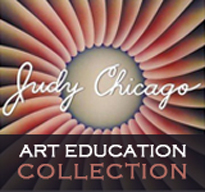Overview and History References
Feminist Pedagogy
Feminist Art
Feminist Theory
Participatory Democracy and Art
Overview and History References:
Ellsworth, E. (1992). Why doesn’t this feel empowering? Working through the repressive myths of critical pedagogy. In C. Luke & J. Gore (Eds.), Feminisms and critical pedagogy (pp. 90-119). New York: Routledge.
Chicago, J. (1996). Beyond the Flower: The autobiography of a feminist artist. New York: Viking.
Forrest, L. & Rosenberg, F. (1997). A review of the feminist pedagogy literature: The neglected child of feminist psychology. Applied & Preventive Psychology, 6, 179-192.
Garber, E. (2003).Teaching about gender issues in the art education classroom: Myra Sadker Day. Studies in Art Education, 45 (1), 56-72.
hooks, b. (1994). Teaching to transgress: Education as the practice of freedom. New York: Routledge.
Kimmel, E. (1999). Feminist teaching, an emergent practice. In S. Davis, M. Crawford, & J. Sebrechts (Eds.), Coming into her own: Educational success in girls and women (pp. 57-76). San Francisco, CA: Jossey-Bass.
Lather, P. (1991). Getting smart: Feminist research and pedagogy within the postmodern. New York: Routledge.
Maher, F. A. & Tetreaut, M. K. (1994). The feminist classroom. New York: Basic Books.
Manicom, A. (1992). Feminist pedagogy: Transformations, standpoints, and politics. Canadian Journal of Education, 17, 365-389.
Schwibs, S. (Producer). (2002). No compromise: Lessons in feminist art with Judy Chicago [Film]. (Available from Indiana University: WTIU, the IU TV station in cooperation with Instructional Support Services, 812-855-5900)
Tomlinson, M. J. & Fassinger, R. E. (2002). The faces of feminist pedagogy: A survey of psychologists and their students. In L. H. Collins, M. R. Dunlap & J. C. Chrisler (Eds.), Charting a new course for feminist psychology (pp. 37-64). Wesport, CT: Praeger.

Leave a Reply
You must be logged in to post a comment.